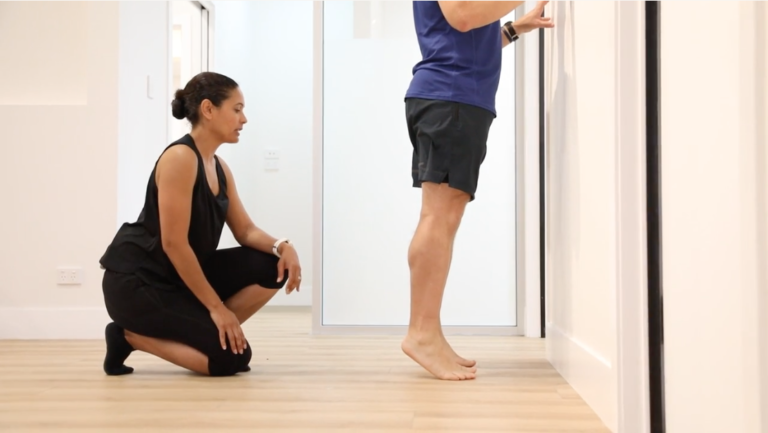Achilles Tendon Pain? Here Are The Causes (And Leading Treatments)
The achilles tendon is a cause of concern for many. It’s vital to everything from cycling to running to walking, and when injured, can significantly affect a person’s quality of life.
Thankfully, non-invasive measures like strengthening, choosing appropriate footwear, focused shockwave therapy, and undertaking targeted physiotherapy are all that’s needed in most cases to manage injury to the achilles tendon, as well as restore movement and function.

What are the Symptoms of Achilles Tendinopathy?
Persistent achilles tendon pain, or ‘achilles tendinopathy’, often begins as an ache in the back of the ankle after playing sports like basketball, soccer, tennis, or after running. It’s also been known to present following gentler activities, such as climbing stairs and walking. The key cause is a change, usually an increase, in activity or loading.
While this pain may subside temporarily with rest, those who experience it commonly report tenderness and stiffness in the heel upon waking – a discomfort that improves as the area ‘warms up’ throughout the day.
When the condition progresses, it may cause parts of the tendon to become thicker and harder, further reducing mobility and escalating pain. They can become very stubborn if not managed early.
What are the Achilles Tendinopathy Risk Factors?
Achilles tendon pain can have a multitude of causes, and while physical activity is the primary trigger, the following are pertinent risk factors:
Age
Because the water content of tendons decreases with age, these tissues gradually become stiffer and less able to tolerate a change or increase in load, leaving them more prone to injury (1).
Foot Mechanics
People that have over-pronated or flat feet are more likely to experience achilles tendon pain. The lack of foot arching in these cases places additional tension on the calf muscles, and in turn, the achilles. Over time, this may cause pain and swelling of the tendon (2).
Obesity
Being overweight or obese means the achilles tendon bears a greater load and more stress during movement.
Training Choices
This includes using incorrect running shoes, increasing your running training too quickly, or running on flat or hilly terrain. Inadequate preparation for many forms of physical activity can heighten your risk for developing an achilles injury. If you are playing sport, pre-season training including stretching and strengthening of the leg muscles will reduce the risk of achilles issues (3).
How is Achilles Tendon Pain Treated?
Recovery from achilles tendon pain is highly dependent on the severity of the condition, the physical activity of the person in question, and how consistently they follow the recommended course of treatment.
Some of the more commonly prescribed therapies include:
Physiotherapy
Early and accurate diagnosis by a physiotherapist specialising in foot and ankle pain is vital for a quick recovery.
Current evidence suggests isometric and eccentric exercises are important for the recovery and health of the achilles. These accentuate the ‘lengthening phase’ of movements, and while the exact mechanism by which they alleviate achilles tendinopathy isn’t fully understood, they have proven effective in both managing pain and restoring function (4).
In addition to manual manipulation and strengthening, a physiotherapist may recommend orthotic devices. These shoe inserts elevate your heel to ease tension on the achilles tendon and cushion it from excess force.
During recovery, physiotherapists can guide you with low-impact rehabilitation so that you can safely maintain your overall activity and health. It’s then vital that you have a graded and sensible re-loading and return to sports or activity rehab plan so you can get back to doing what you love.
Focused Shock Wave Therapy
Used as an adjunct to more traditional physiotherapy practices, focused shockwave therapy has shown great promise in the management of hard to treat conditions like achilles tendinopathy.
It involves directing targeted acoustic energy into the affected tissue via a handheld device. The procedure is non-invasive, and has shown “statistically significant improvement for outcomes of pain and function” (5).
Drugs
While corticosteroid injections used to be recommended, they are now rarely administered due to the potential to weaken the tendon. In one as frequently used as the achilles, this could lead to further disability and even rupture (6).
Surgery
If less radical treatment options fail, or the tendon has torn completely, surgery may be required to repair the achilles tendon. In such a case, it’s necessary to engage in appropriate post-surgery physiotherapy to regain function and strength.
What should you do if you experience Achilles Tendon Pain?
If you experience achilles tendon pain, it’s important to consult with a qualified health professional. An accurate diagnosis is vital to get you on the correct management plan. Reliable and experienced physiotherapists, like those at E3 Physio, will be able to pinpoint the source of your discomfort, as well as administer proven and effective therapies.
At E3, we help patients manage achilles pain through a combination of manual and active treatment including joint mobilisation, stretching, and strengthening exercises. Additionally in some cases we find focused shockwave therapy can be a helpful addition to our care. This multifaceted approach has allowed countless clients to overcome pain and return to doing the things they love.
You can reach out to our friendly team via phone, or book an appointment online.
References
- https://orthoinfo.aaos.org/en/staying-healthy/effects-of-aging/
- https://www.betterhealth.vic.gov.au/health/conditionsandtreatments/achilles-tendonitis
- https://www.mayoclinic.org/diseases-conditions/achilles-tendinitis/symptoms-causes/syc-20369020
- https://www.ncbi.nlm.nih.gov/pmc/articles/PMC4527202/
- https://complete-physio.co.uk/shockwave-therapy-for-insertional-achilles-tendinopathy/
- https://www.verywellhealth.com/using-cortisone-injections-to-treat-achilles-problems-2549414

